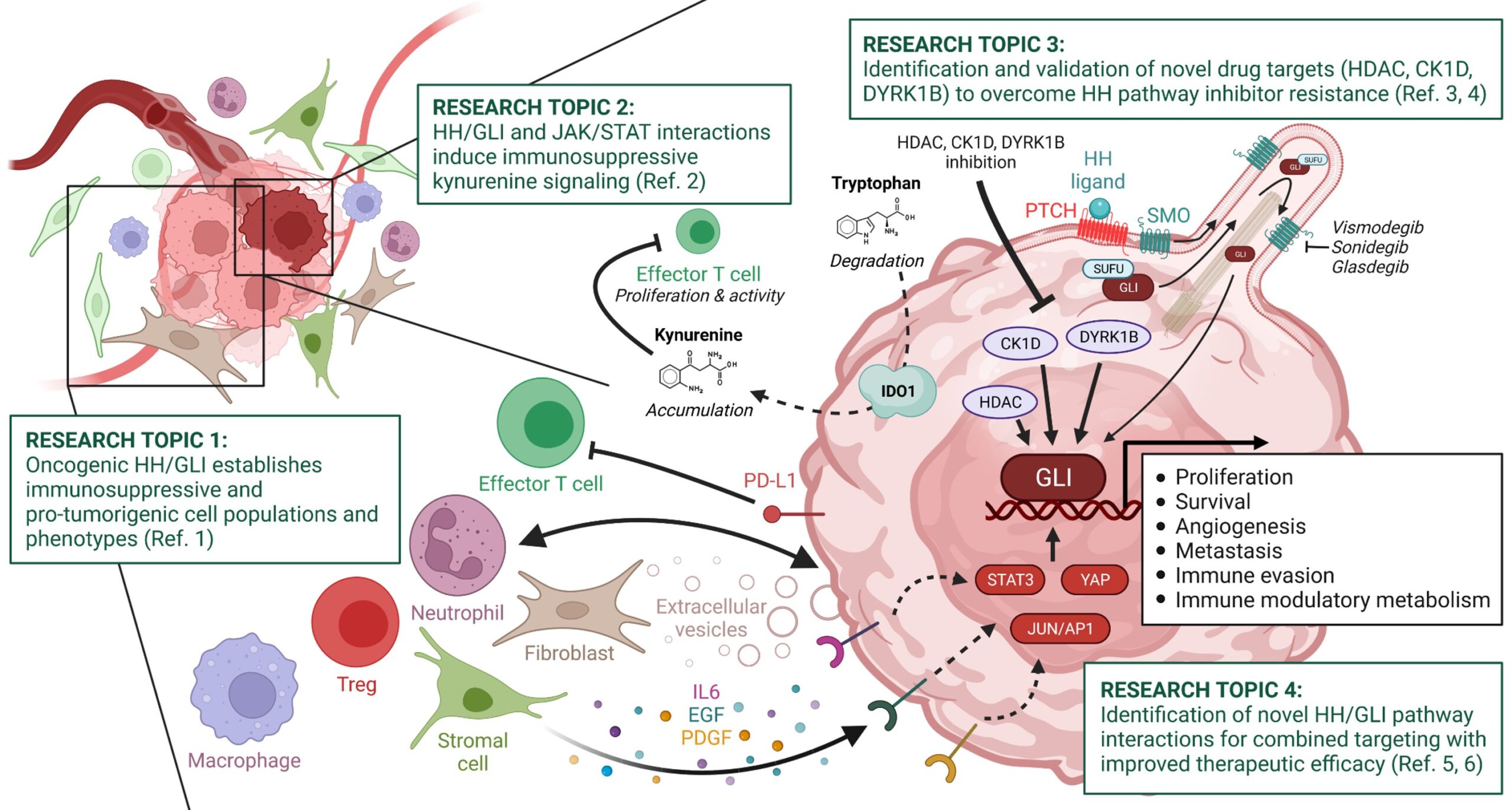Research focus of the Aberger lab
The major focus of the Aberger group is to understand the intricate molecular and cellular communication processes in the context of malignant development. The lab studies therapeutically relevant cancer stem cell signaling pathways (e.g. Hedgehog/GLI and JAK/STAT signaling), their cross-talk and integration with other oncogenic cues including inflammatory signals and their role in the modulation of the tumor microenvironment and the anti-tumor immune response.
The group applies a combination of in vivo cancer models in combination with cellular, molecular, spatial and systems biology approaches to decipher the regulation of signaling pathways in malignant diseases and to understand mechanisms of drug resistance.The overall aim of the work is to develop efficacious rationale-based combination therapies based on simultaneous targeting of oncogenic signals and immunosuppressive pathways for better and durable responses.
This comprehensive approach has already proven successful. For instance, the Aberger lab has identified several synergistic interactions of the Hedgehog pathway, accounting for malignant progression of various cancer entities. These discoveries have laid the basis for the development of rationale-based combination treatments with improved efficacy by simultaneously targeting cooperating oncogenic signals.

Selected publications:
- Elmer, D. P., Stockmaier, G., Grund-Gröschke, S., Strobl, V., Dang, H.-H., Wiederstein, M., Licha, D., Strobl, A., Eglseer, A., Sternberg, C., Tesanovic, S., Gruber, W., Wolff, F., Moriggl, R., Risch, A., Reischl, R., Huber, C. G., Krenn, P. W., Fortelny, N., … Aberger, F. (2025). Cooperative Hedgehog/GLI and JAK/STAT signaling drives immunosuppressive tryptophan/kynurenine metabolism via synergistic induction of IDO1 in skin cancer. Cell Communication and Signaling, 23(1), 91. https://doi.org/10.1186/s12964-025-02101-6
- Rathje, F., Sykora, M. M., Aberger, F., & Krenn, P. W. (2025). High Efficiency Lentiviral Transduction of Colon Organoids Using Reversible 2D/3D Culture Techniques. Methods in Molecular Biology (Clifton, N.J.), 2905, 245–254. https://doi.org/10.1007/978-1-0716-4418-8_16
- Stockmaier, G., Varkhande, S. R., Krenn, P. W., Hieu-Hoa, D., Sharma, A., Elmer, D. P., Steiner, M., Zaborsky, N., Neureiter, D., Greil, R., Horejs-Hoeck, J., Fortelny, N., Gratz, I. K., & Aberger, F. (2024). Hedgehog-Hippo pathway interactions promote T cell exclusion from the tumor microenvironment in basal cell carcinoma. BioRxiv, 2024.07.07.602398. https://doi.org/10.1101/2024.07.07.602398
- Krenn, P.W., and Aberger, F. (2023). Targeting cancer hallmark vulnerabilities in hematologic malignancies by interfering with Hedgehog/GLI signaling. Blood. 10.1182/blood.2021014761.
- Peer E, Aichberger SK, Vilotic F, et al. Casein Kinase 1D Encodes a Novel Drug Target in Hedgehog-GLI-Driven Cancers and Tumor-Initiating Cells Resistant to SMO Inhibition. Cancers (Basel). 2021;13(16).
- Rathje, F., Klingler, S., and Aberger, F. (2022). Organoids for Modeling (Colorectal) Cancer in a Dish. Cancers (Basel) 14, 5416. 10.3390/cancers14215416.
- Grund-Groschke S, Ortner D, Szenes-Nagy AB, et al. Epidermal activation of Hedgehog signaling establishes an immunosuppressive microenvironment in basal cell carcinoma by modulating skin immunity. Mol Oncol. 2020.
- Grund-Groschke S, Stockmaier G, Aberger F. Hedgehog/GLI signaling in tumor immunity – new therapeutic opportunities and clinical implications. Cell Commun Signal. 2019;17(1):172.
- Gruber, W., Peer, E., Elmer, D.P., Sternberg, C., Tesanovic, S., Del Burgo, P., Coni, S., Canettieri, G., Neureiter, D., Bartz, R., Kohlhof, H., Vitt, D., and Aberger, F. (2018). Targeting class I histone deacetylases by the novel small molecule inhibitor 4SC-202 blocks oncogenic hedgehog-GLI signaling and overcomes smoothened inhibitor resistance. Int. J. Cancer 142, 968-975. 10.1002/ijc.31117.
- Sternberg C, Gruber W, Eberl M, Tesanovic S, Stadler M, Elmer DP, Schlederer M, Grund S, Roos S, Wolff F, Kaur S, Mangelberger D, Lehrach H, Hache H, Wierling C, Laimer J, Lackner P, Wiederstein M, Kasper M, Risch A, Petzelbauer P, Moriggl R, Kenner L, Aberger F. Synergistic Cross-Talk of Hedgehog and Interleukin-6 Signaling Drives Growth of Basal Cell Carcinoma. International journal of cancer 2018. 10.1002/ijc.31724.
- Gruber W, Hutzinger M, Elmer DP, Parigger T, Sternberg C, Cegielkowski L, Zaja M, Leban J, Michel S, Hamm S, Vitt D, Aberger F. DYRK1B as therapeutic target in Hedgehog/GLI-dependent cancer cells with Smoothened inhibitor resistance. Oncotarget 2016; 7(6):7134-48.
- Kern D, Regl G, Hofbauer SW, Altenhofer P, Achatz G, Dlugosz A, Schnidar H, Greil R, Hartmann TN, Aberger F: Hedgehog/GLI and PI3K signaling in the initiation and maintenance of chronic lymphocytic leukemia. Oncogene 2015 34(42):5341-51.
- Pencik J, Schlederer M, Gruber W, Unger C, Walker SM, Chalaris A, Marié IJ, Hassler MR, Javaheri T, Aksoy O, Blayney JK, Prutsch N, Skucha A, Herac M, Krämer OH, Mazal P, Grebien F, Egger G, Poli V, Mikulits W, Eferl R, Esterbauer H, Kennedy R, Fend F, Scharpf M, Braun M, Perner S, Levy DE, Malcolm T, Turner SD, Haitel A, Susani M, Moazzami A, Rose-John S, Aberger F, Merkel O, Moriggl R, Culig Z, Dolznig H, Kenner L. STAT3 regulated ARF expression suppresses prostate cancer metastasis. Nat Commun. 2015 Jul 22;6:7736.
- Eberl M, Klingler S, Mangelberger D, Loipetzberger A, Damhofer H, Zoidl K, et al. Hedgehog-EGFR cooperation response genes determine the oncogenic phenotype of basal cell carcinoma and tumour-initiating pancreatic cancer cells. EMBO Mol Med 2012;4:218-33.
- Teperino R, Amann S, Bayer M, Mcgee SL, Loipetzberger A, Connor T, et al. Hedgehog Partial Agonism Drives Warburg-like Metabolism in Muscle and Brown Fat. Cell 2012;151:414-26.
- Schnidar H, Eberl M, Klingler S, Mangelberger D, Kasper M, Hauser-Kronberger C, et al. Epidermal Growth Factor Receptor Signaling Synergizes with Hedgehog/GLI in Oncogenic Transformation via Activation of the MEK/ERK/JUN Pathway. Cancer Research 2009;69:1284-92.





